Rugby STW – BioMag Plant (2020)
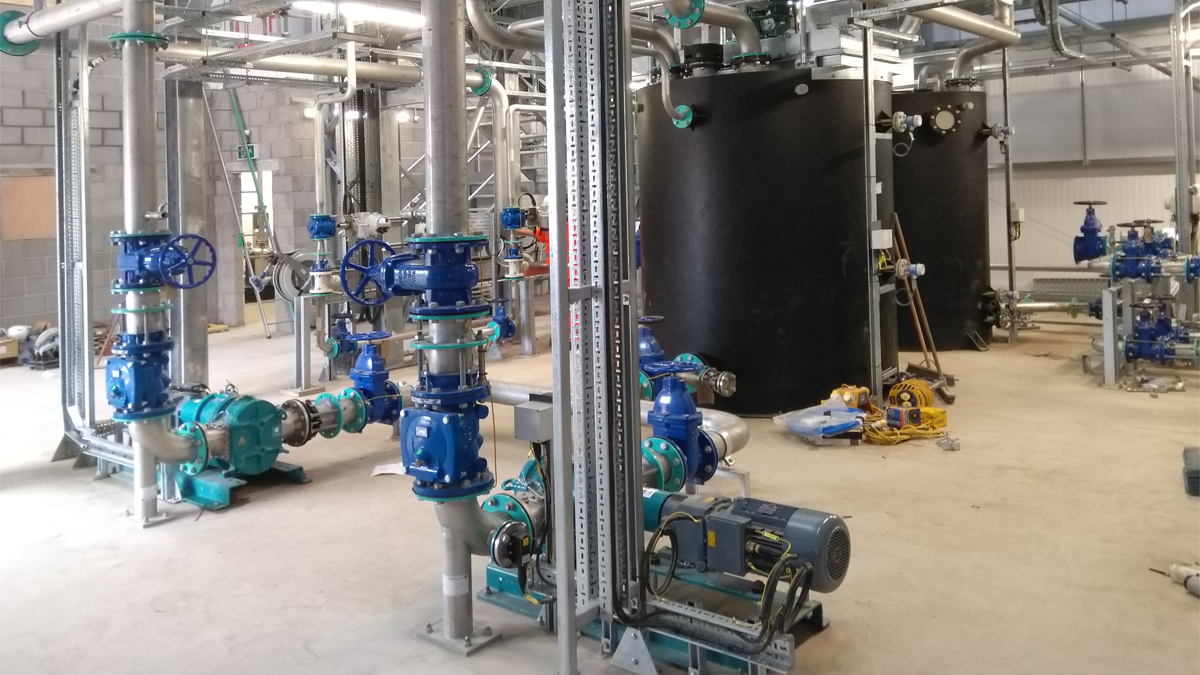
BioMag plant - surplus activated sludge tank (SAS) and magnetite remix tank with associated pipework - Courtesy of CiM6
Rugby STW is situated on the south bank of the River Avon, approximately 1km north of the town of Rugby in Warwickshire. Final effluent from Rugby STW is discharged into the River Avon and needs to meet permits set by the Water Framework Directive (WFD). It provides sewage treatment to a population of circa 107,975. The existing process includes inlet screens, storm tanks, grit separation, 3 (No.) radial flow primary settlement tanks, ferrous chloride dosing into settled sewage, 4 (No.) oxidation ditches, 6 (No.) radial flow final settlement tanks (FST) and tertiary deep bed sand filters (partially abandoned). The site is also a sludge reception centre and has the capability to treat indigenous and imported sludges. The sludge treatment facilities include thickening, digestion, pathogen kill tanks and digested sludge storage tanks for export.
Project drivers
In AMP6, Severn Trent was delivering a major capital investment project due to a tightening of the phosphorus effluent limit as a result of the WFD drivers. In order to improve river quality to WFD Good status, the following final effluent performance is required:

Table 1: Old and new discharge permit criteria for Rugby STW
To meet the future and current permit requirements at Rugby STW, both the biological and hydraulic capacity of the works had to be upgraded. In addition, phosphorus removal had to be improved from existing levels to account for current and future growth of 14% in the connected population for a year 2028 design horizon.
The AMP6 One Supply Chain Partner, CiM6 (a collaboration between Costain and Stantec UK) was appointed to design and deliver a solution by the end of AMP6. The budget for the project was £6.5m.
The solution
The process solution to meet the site consent was to implement a new ballasted flocculation and clarification system, BioMag® plant, the first permanent full-scale installation in the United Kingdom. To facilitate the implementation of this new technology, the existing activated sludge plant (ASP) needed to be upgraded.
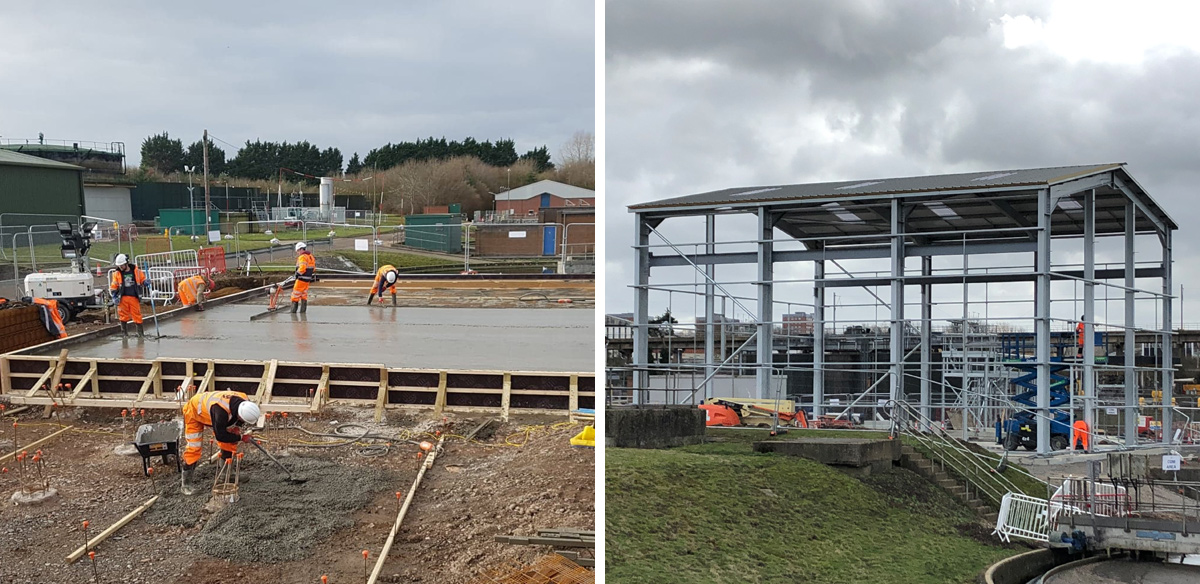
BioMag building (left) storage silo base slab construction and (right) the building construction underway – Courtesy of CiM6
The BioMag plant is a secondary process enhancement which comprises of a magnetite recovery system – including shear mills and magnetic drum separators, waste sludge transfer system, magnetite remix system, proprietary control system software and MCC, polyelectrolyte storage, and dosing plant. The BioMag plant at Rugby also needed a delivery area with associated storage and feed system with an expected storage of 50 days. The BioMag equipment is easily located in a building local to the existing ASP/FSTs thus ensuring construction could occur without major disruption to the operation of the existing plant. As a result of the introduction of BioMag at the Rugby site, the quality of effluent leaving the works meets the new permits without the need to invest in refurbishing the tertiary deep bed sand filters, which are no longer required. With the addition of the magnetite, the hydraulic capacity of the FSTs was increased due to the enhanced settlement efficiency.
In addition to the ASP upgrade, capital maintenance improvements were also required. These improvements included refurbishing the FST scrapers including new underwater gear, refurbishment of the existing mammoth surface aerators including new gear box and drives, installation of return liquor buffer tank at the inlet works, screening on primary sludge feed to picket fence thickeners, and adjustments to the existing ferrous chloride dosing system for a new ferric sulphate dosing system.
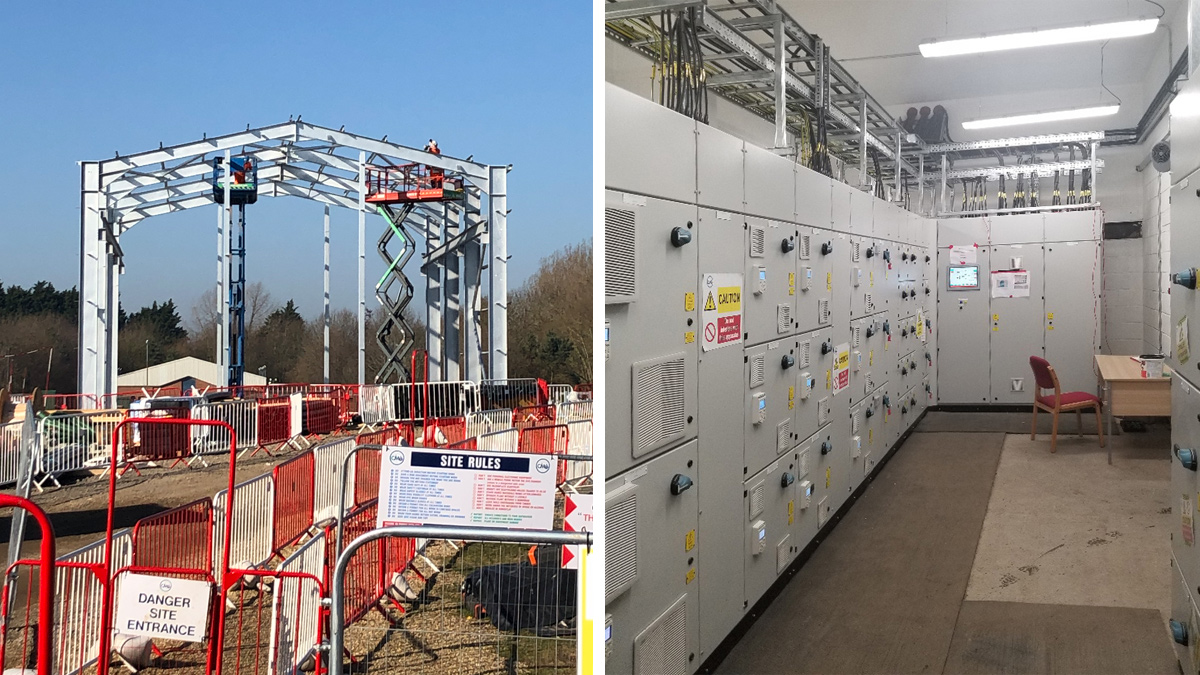
(left) BioMag building under construction and (right) MCC room within building – Courtesy of CiM6
Design
The combined CiM6 and Severn Trent philosophy throughout this project was collaboration and to engineer solutions that maximise efficiency and deliver cost effective outcomes. This principle was applied from the start of the project. CiM6 were involved at the very early stages and worked alongside Severn Trent to help inform the decision for a single process solution. Through case studies of available technologies, sharing of worldwide technical expertise by Stantec UK and extensive consultation with Severn Trent, the technology partners selected were Evoqua Water Technologies (EWT) for the supplementary secondary treatment. Eliquo Hydrok Ltd was selected for supplementary aeration. Both technology partners were selected through a competitive bid process.
BioMag was identified as a TOTEX effective treatment option for Rugby STW. The use of BioMag (magnetite ballasted settlement) enables enhanced settlement rates within the final settlement tanks which allowed higher MLSS values within the existing ASP reactors without compromising the final settlement tanks (FSTs) solids removal performance.
The ballasted MLSS allowed higher than normal flux loadings onto the FSTs with the settlement of the biological solids two to four times faster than conventional solids settlement. Adoption of the BioMag technology at Rugby meant that Severn Trent did not need a further tertiary treatment process to achieve the required effluent quality.
Detailed design for the project was been completed by CiM6’s design partner, Stantec UK. Detailed design included process, civil, mechanical, electrical, geotechnical design, environmental and planning. Additional process design was provided by EWT who provided the BioMag technology and Eliquo Hydrok Ltd who provided the FBDA supplementary aeration system within the oxidation ditches.
A comprehensive 3D model utilising the Bentley CAD software was used throughout the project to generate the construction drawings but also to facilitate collaborative design developments. Sub-supplier models were successfully integrated into the overall model to further enhance the design development process. Using a comprehensive 3D model, it was possible to have an effective access lifting and maintenance review with STWL operational staff. The software allowed for better visualisation of what the overall site/plant would look like once constructed. The 3D integrated model also helped conceptualise the new works. This, coupled with successful collaboration, lead to a successful HAZOP meeting, that drew out hazards associated with the plant leading to a safer and more efficient design for Severn Trent.
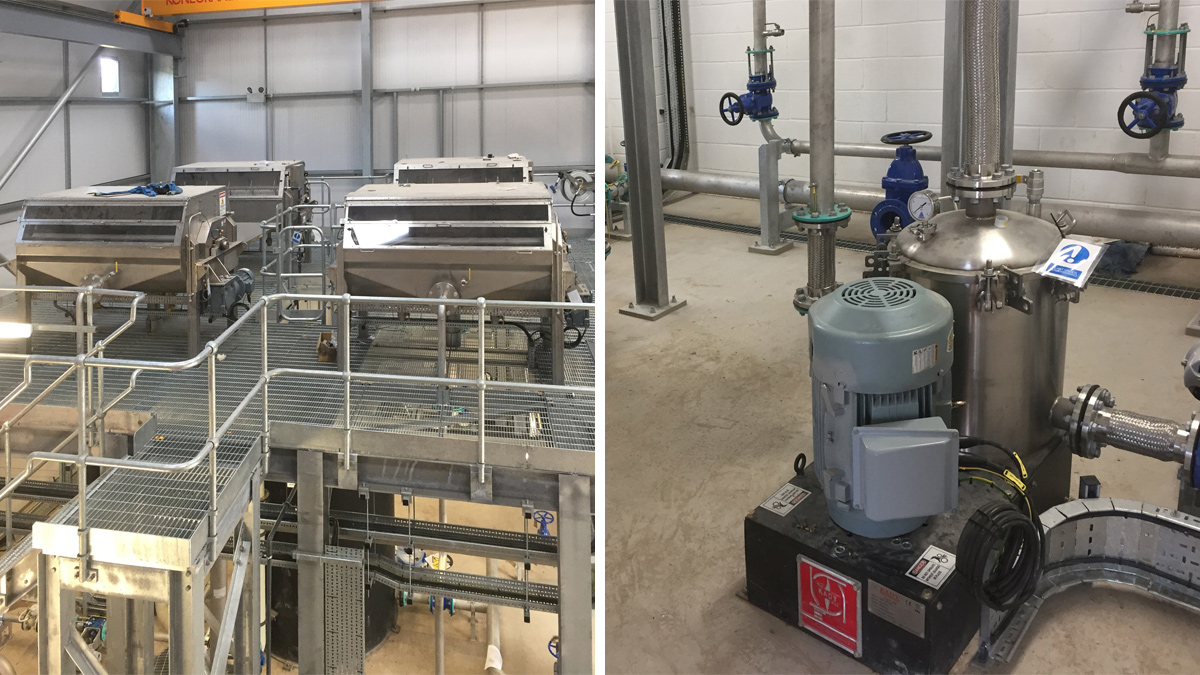
BioMag plant (left) magnetite recovery drums and (right) shear mills – Courtesy of CiM6
New works: Enhanced secondary treatment
The BioMag process is based on adding ballast to the activated sludge process making the SG of the biological flocs heavier and easier to settle. The ballast material is magnetite (Fe3O4), fully inert, high specific gravity (5.2), finely ground, non-abrasive, iron ore. The enhanced settlement rate allows for a greater flux load to be applied to the final settlement tanks. This, in turn, allows the aeration section to operate at a higher mixed liquor suspended solids (MLSS) concentration, allowing for better treatment or capacity for additional load.
Due to its hydrophobic nature and simple mixing, the magnetite is infused into the biological floc thereby significantly increasing the specific gravity of the floc. When the magnetite infused flocs are introduced to the FST, the flocs settle many times faster than conventional flocs. The rapid settling enables the BioMag systems to treat significantly larger flows through the same clarifier and achieve a better quality of effluent leaving the FST. The magnetite ballast is recovered from the waste sludge magnetically and returned to the treatment system with minimal magnetite loss, contributing to the goal of keeping consumable costs to a minimum.
A key feature of the BioMag technology is the increased secondary solids settling rates that ensure secure and reliable control of the secondary clarifier effluent and sludge blankets. This enables the biological treatment to operate at elevated MLSS concentrations. This can either enable the processing of higher flows or if capacity is not an issue, the reconfiguration of current tanks to support the achievement of total nitrogen and/or phosphorus discharge limits.
In summary, the BioMag system offered a simple, reliable, and highly effective process that suited the requirements at Rugby. The main difference between the BioMag system and a conventional activated sludge system is the simple side stream process dealing with the surplus activated sludge (SAS). The SAS is first passed through a shear mill to break up the floc and then into a magnetic recovery drum where the magnetite is recovered. The biological sludge is then sent for further conventional treatment.
The recovered magnetite is directed to a small ballast mix tank or similar where virgin and recovered magnetite is blended with a proportion of the surplus activated sludge (SAS). The magnetite becomes embedded into the biological floc. The ballasted biosolids are then conveyed back to the biological process to enhance settling in the secondary clarifiers after passing through the ASP. Most of the volume of the RAS is withdrawn from the bottom of the clarifier as per normal and returned to the head of the ASP – like a conventional ASP.
The BioMag plant and equipment is housed within a steel portal frame structure which was designed and installed by DPL Steel Buildings Ltd. Using models from different suppliers and integrating them into CAD, it was possible to ideally position all plant and equipment within the building to avoid clashes with steel supports/members or other fittings/fixtures.
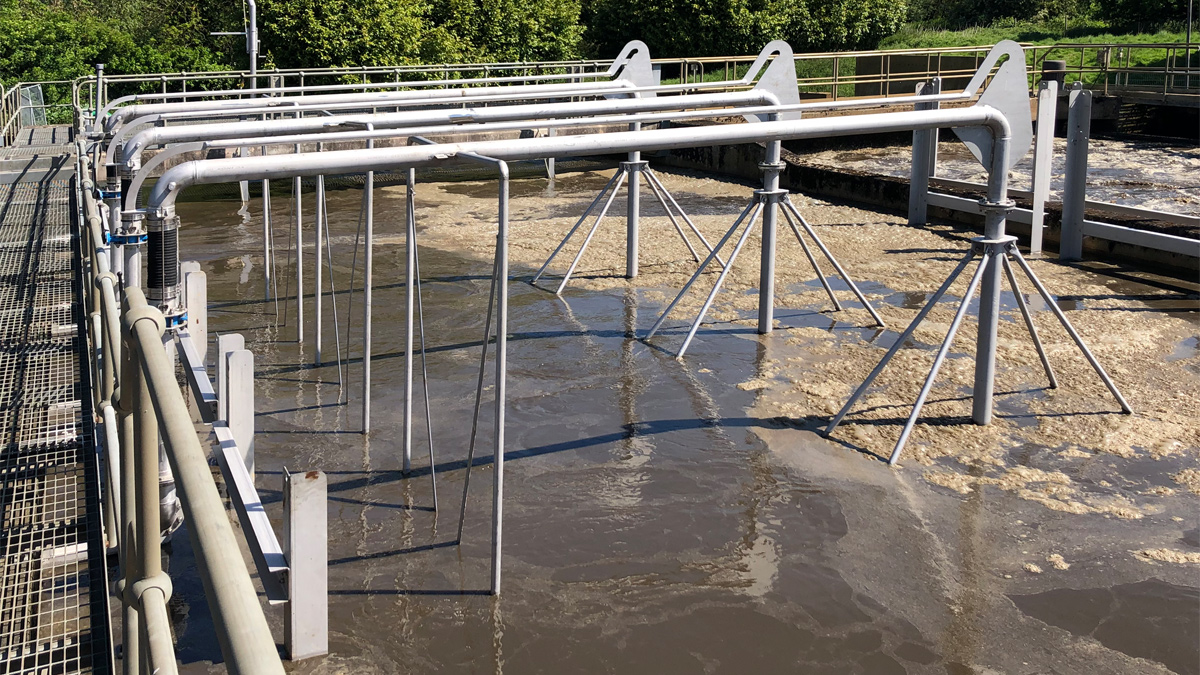
Eliquo Hydrok FBDA supplementary aerators – Courtesy of CiM6
New works: Supplementary aeration system
The existing activated sludge plant at Rugby consisted of two separate pairs of oxidation ditches (four oxidation ditches in total). Each pair is served by a common anoxic selector zone. Each oxidation ditch is equipped with 3 (No.) 9m long axial Passavant Mammoth rotors.
Future catchment growth will result in aeration requirements peaking above the existing oxygen transfer rates, leaving a theoretical shortfall within the system. Therefore, a new supplementary aeration system was needed to account for the shortfall. The new system was designed and installed by Eliquo Hydrok Ltd. The system comprised of 3 (No.) variable speed drive blowers in a duty/duty/standby configuration, serving new removable fine bubble diffused aeration (FBDA) grids in all four ditches. The existing Mammoth rotors were also refurbished as part of this project to ensure that future capabilities are met. This involved replacing existing gearboxes, missing teeth on rotors and some existing motors.
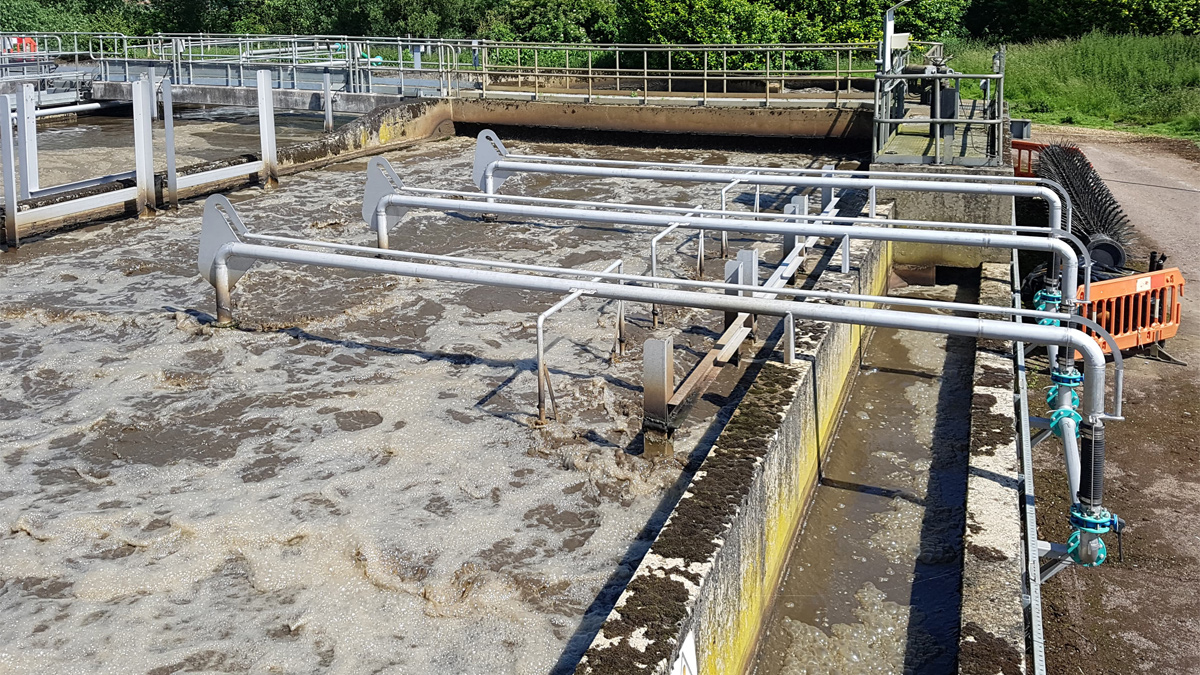
Eliquo Hydrok FBDA supplementary aerators and pipework – Courtesy of CiM6
New works: Final effluent pumping station
The existing site washwater did not have enough capacity in the system to provide the supply needed for the new works. A new washwater pumping station, designed by Stantec UK, was fed from the existing final effluent channel. The system was needed to provide a continuous washwater supply to the BioMag package plant, for carrier water to the polymer dosing system and for the sludge screen installed upstream of the picket fence thickeners.
Existing works modifications
The BioMag technology for Rugby STW was installed on a pre-existing site and therefore certain adjustments to the existing system needed to be made to ensure that the BioMag technology worked as planned. The biological floc has a higher SG when infused with the magnetite settlement. EWT process required that 0.6 m/s was maintained within pipelines to re-suspend any settled magnetite within the system.
EWT carried out CFD modelling of the oxidation ditch to ensure the performance of the technology within the system. Stantec UK were able to hydraulically model the existing process pipelines to check the pipe velocities and hydraulics. It was found that the existing 1,050mm diameter process pipes from oxidation ditches to the distribution chambers could not achieve the required velocity. Therefore, new 700mm diameter pipes were installed on the oxidation ditches with new weir chambers. The existing weirs and pipes were abandoned and blocked off.
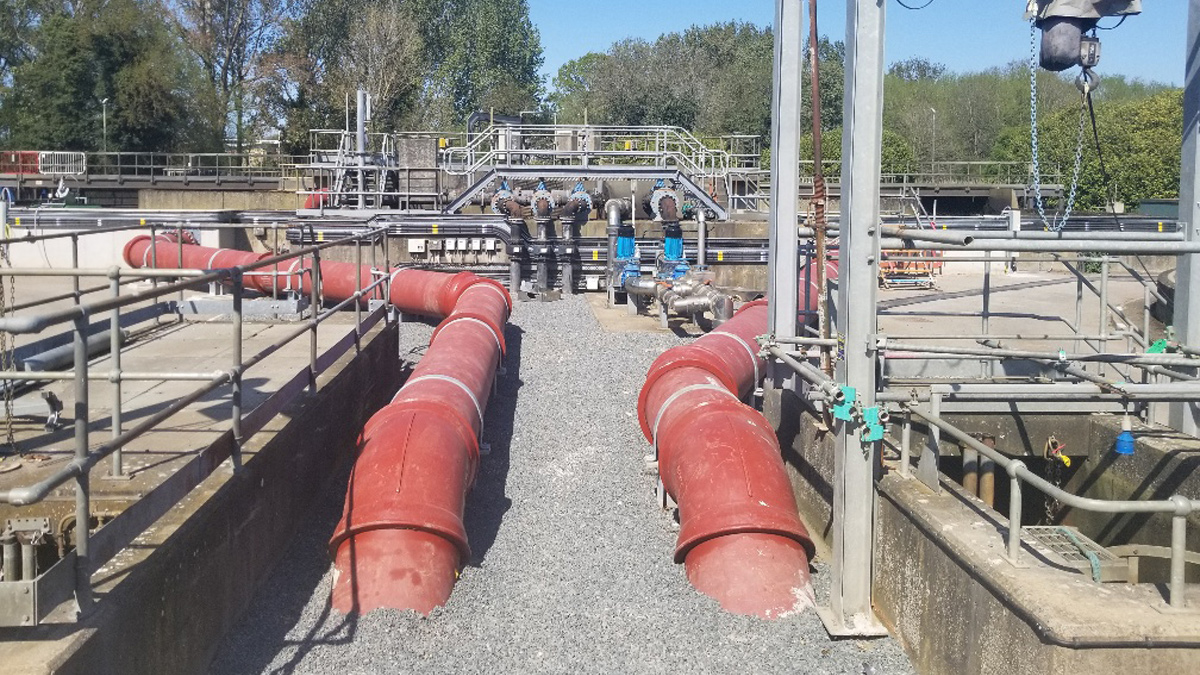
New 700mm diameter process pipework from oxidation ditches to distribution chamber – Courtesy of CiM6
Stantec UK also worked with Hydrotec (UK) Ltd to analyse the final distribution chambers to determine the velocities in each chamber due to the risk of settlement of the dosed magnetite. It was also possible to determine the flow distribution of the existing outlet streams at various flow ranges. It was found that there were areas of low velocity within the chamber and potential areas for the magnetite to settle. Hydrotec provided a solution to the problem by modelling a mixer within the chamber in an ideal location to keep all magnetite suspended within the system.
CiM6’s understanding of the engineering challenges associated with pipelines and flow distribution chambers combined with Hydrotec’s expertise in CFD and physical modelling, enabled pinpoint problem identification and resulted in delivery of an optimised solution to Severn Trent.
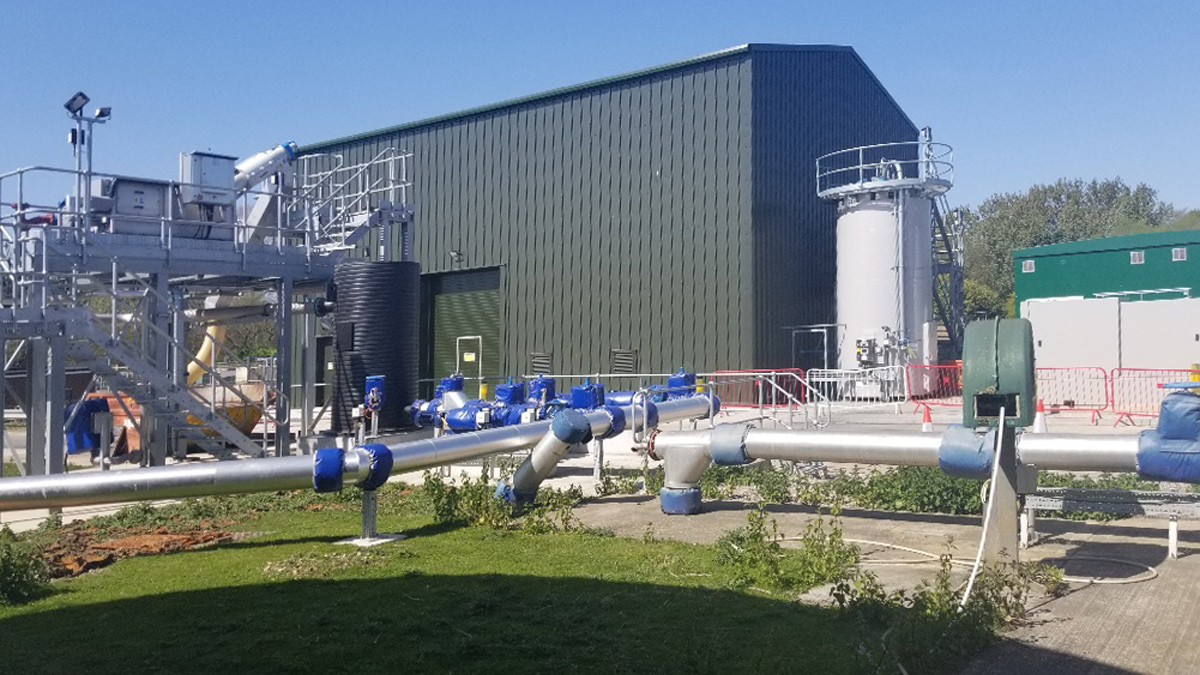
Rugby STW – Courtesy of CiM6
Rugby STW BioMag Plant: Supply chain key participants
- Project delivery: CiM6 (Costain/Stantec UK)
- CFD modelling: Hydrotec
- Civil sub-contractor: Hollywood Engineering
- Pile foundation design & install: Ivor King The Piling People
- Portal frame detailed design & steelwork installation: DPL Steel Buildings
- Building heating & ventilation: Air Technology Systems (ATS)
- BioMag technology: Evoqua Water Technologies (Xylem Water Solutions)
- Fine bubble diffused aeration system: Eliquo Hydrok Ltd
- Polymer dosing plant: Richard Alan Engineering
- MCC control panels: CEMA
- Blower supplier: Aerzen Machines
Conclusion
At the time of writing the paper (May 2020), the BioMag system has been installed and commissioned. It is currently undergoing optimisation. Completion and handover of the project is scheduled for early summer 2020. The upgraded treatment works will be capable of meeting the new permit requirements and future growth in the catchment area.









